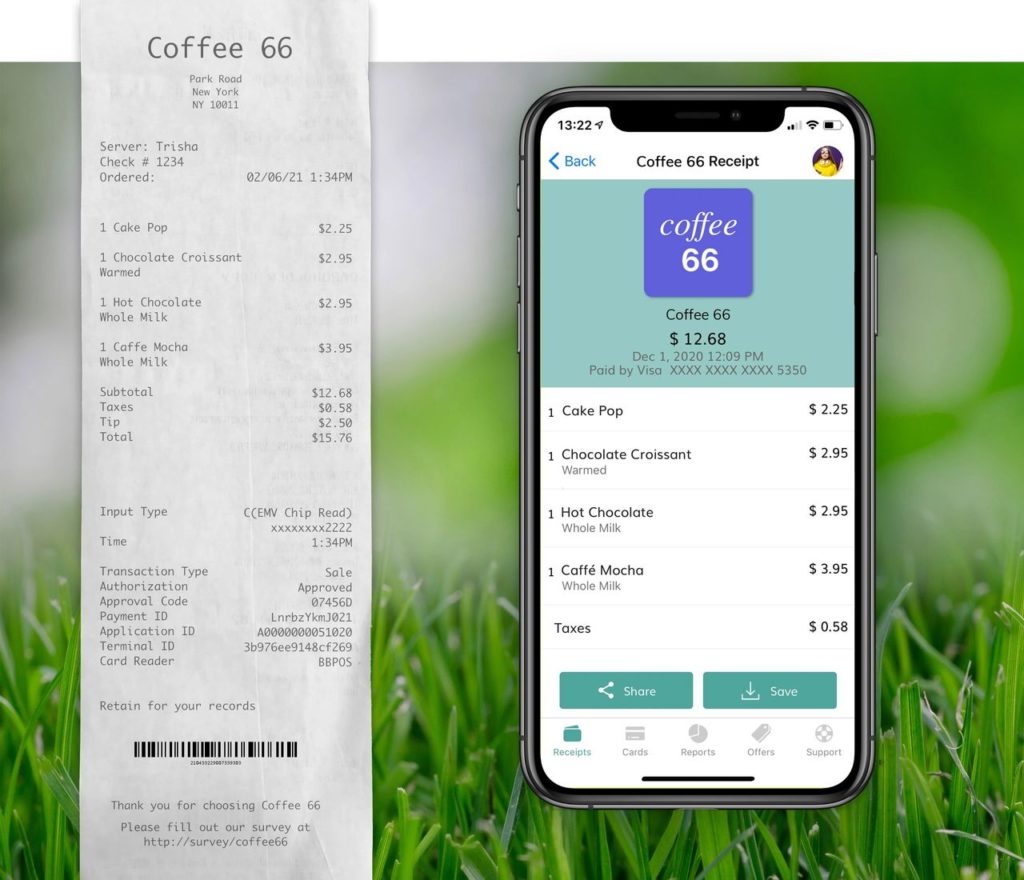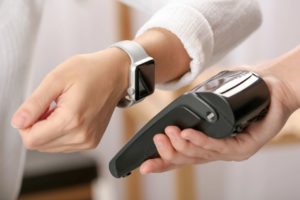Swap that Messy Shoebox for Digital Proof-of-Purchase
At best, paper receipts are a low-grade headache of modern living. Whether shoved in our pockets to magically multiply, fed to bloated shoe boxes beneath our beds, or tossed straight in the waste bin – they’re everywhere.
All these tiny slips pile up: we used an estimated 400,000 metric tons of receipt paper worldwide in 2020. That’s roughly the weight of 2,000 blue whales.
Consumers need receipts for returns and recordkeeping –but does it have to be a paper slip? Let’s take a look at a few reasons the switch to digital receipts is long overdue.
1. Paper Receipts are Bad for the Planet
Many retailers print receipts automatically, so it’s easy to run a few errands and collect a pocket full of paper. And if we’re not saving them for returns or recordkeeping, they usually make a beeline for the trash.
Of the 11 billion receipts printed in the UK each year, nearly 9.9 billion are thrown away unused. That’s the equivalent of 53,000 trees going straight in the bin – almost all the trees in London’s eight royal parks.
Whether or not we use them, paper receipts cost resources to create. Globally, we consume an estimated 25 million trees every year to produce receipt paper. This contributes to global deforestation – driving habitat loss, species decline, and the release of harmful greenhouse gas.
Digital receipts leave forests intact. And forests return the favor by absorbing CO2. In fact, a single tree can accommodate the emissions produced by 5,400 digital receipt emails every year – as long as it’s left standing.
A Waste Forest Beyond the Trees
The carbon footprint of a paper receipt increases through every phase of production and distribution. We use resources and energy to harvest trees, process them into paper rolls, and transport them to storefronts worldwide. In the US alone, this adds up to nearly 250 million gallons of oil, 1 billion gallons of water, and 1.5 million pounds of waste each year.
Ditching Paper for the Planet
Numerous major retailers have announced plans to slash their carbon footprints, but they often overlook the benefits of digital receipts. According to Green America, the environmental non-profit behind the “Skip the Slip” movement, a single Walgreens-sized company could save over 55,000 trees, 58.8 million gallons of water, and 17.6 million pounds of CO2 emissions annually by ditching paper receipts.
2. Paper Receipts Contain Harmful Chemicals
Paper receipts aren’t just paper. Over 90% are made of thermal paper coated in bisphenol-A (BPA) or bisphenol-S (BPS). These chemicals react with printer heat to display your purchase information, keeping your receipt legible longer than ink. It’s useful when you need to return your new toaster a month later – but there are troubling consequences.
BPA & BPS are Toxic to Humans
If BPA and BPS ring a bell, it’s because they’ve been the subject of numerous public health disputes. Both chemicals are endocrine disruptors, and have been linked to fetal development issues, reproductive impairment, and type II diabetes, among other health concerns.
BPA & BPS have been banned from consumer plastics like children’s toys and water bottles, but get transferred to your hands (and bloodstream) almost every time you touch a receipt.
Nearly 81% of Americans have detectable levels of BPS in their bodies, and upwards of 90% of the exposure is linked to thermal receipts.
Workers who regularly handle receipts have BPA levels 30% higher than other adults. And since BPA is only detectable in our bodies for a short period, many may regularly exceed European BPA exposure limits.
Recycling? Think Again
Another bit of bad press: thermal receipts can’t be recycled.
Items printed with more than one material are nearly impossible to separate. And recycling paper receipts would release toxic chemicals into the air and environment.
Tossing receipts in the paper bin can contaminate the whole recycling stream. Best case: the items in your bin are tossed out. Worst case: BPA & BPS end up in recycled products like facial tissue, toilet paper, and napkins – exposing our sensitive skin.
Digital receipts create zero physical waste. By storing purchase information in our phones or email inboxes, we keep harmful contaminants out of our recycling stream, protect consumers and employees from chemical exposure, and keep trees in the forest and out of the landfill.
3. Paper Receipts are Inefficient
We keep our contacts in the cloud, pay bills through online portals, and get direct deposits while we sleep. Technological evolution is driven by convenience, and paper receipts are the dinosaurs of our daily habits.
They’re a Hassle to Organize
If you own a business, file expense reports, or simply track your purchases, you’ve probably got a shoebox or manilla envelope bursting with paper receipts. Even for the most type-A among us, keeping things organized is a challenge.
Scanning, sorting, and calculating paper receipts can take hours. Digital receipt apps like e.pop automatically track and tally your purchases to save you the effort. Plus, digital receipts can be sorted with multiple tags – so you don’t need to choose between folders. (That Peloton bike was a wellness purchase and an impulse buy!)
They’re Fragile & Easy to Lose
We throw away or lose half of the receipts we receive – including the ones we meant to save! And the ones we don’t lose track of are easily stained, torn, or damaged. Thermal receipts also fade over time, which can be an issue when we want to return items further down the road.
Lost and illegible receipts are unusable, and getting replacements is a hassle (if possible at all). This leads to financial losses for customers who want to return items, but can’t verify their proof of purchase.
Digital receipt apps store your purchase information automatically, keeping it safe and available until you need it.
4. Digital Receipts are Better Business

Digital receipts are smart for retailers, convenient for consumers, and kinder to the planet. And the market is skewing in their favor: nearly 90% of Americans want retailers to offer virtual proof-of-purchase.
Millennials and Generation Z are the biggest advocates – and as their purchasing power increases, so will the demand for convenient, environmentally-friendly alternatives. Yet only one-third of retailers have gotten on board.
The Cost of Paper Receipts is Rising
The US retail sector spent more than $312 million on paper receipts in 2019. That’s a hefty price to pay to give consumers a free chewing gum receptacle. And thanks to a shortage of the leuco dye used in the printing process, the price of thermal receipts is projected to rise through 2025.
By giving customers the option to receive a digital receipt or opt-out altogether, businesses can save money – and the planet! – in the long run.
What’s Stopping the Rise of Digital?
Digital proof-of-purchase is a practical alternative to inefficient paper receipts. But even though the vast majority of consumers support digital receipt technology, only have 40% have already opted in.
What’s stopping everyone else?
There are several reasons consumers may hesitate to embrace digital receipts. Many are sent via text or email, and patrons can be reluctant to share their contact information with merchants. How can they be certain their data is safe from hackers when it’s stored on dozens of databases?
Often this information exchange takes place in public on a physical terminal, which raises additional security and sanitation concerns. Once sent, texts and emails take up space on our devices – and can get buried in our inboxes and messages without further organization.
Digital Receipt Apps are Simple and Secure
Apps like e.pop help merchants and consumers connect digitally and securely. Merchants can send customers digital receipts through the app without requesting an email address or phone number. And with similar security tech as apps like Venmo, users’ contact information is kept private and protected. Purchase information is stored automatically – saving customers the added efforts and messy email inbox.
What you can do to ditch the slip
Receipts may not be around forever. In fact, regulatory wheels are being set in motion left and right to make digital receipts a default and veto BPA-coated paper receipts as the default. France, for example, will enforce e-invoicing by 2024, incrementally eliminating paper receipts as standard. Dubbed the “anti-waste law”, the French government will start with larger companies and work its way towards smaller merchants, and has included malls, shops, car parks and ATMs into the regulation. Similarly to plastic bags, if you want one, you will have to ask for it specifically.
Paper receipts are wasteful, toxic, and non-recyclable and several alternatives for them exist. The first? You. Try to be mindful of when you actually need a receipt, when asked. If you do need a receipt, digital receipts are a very convenient (and sustainable) alternative. By getting them sent your way digitally, you are reducing the demand for a physical copy – and when we work together to reduce demand, production will lower right along side it. The most convenient and efficient way, however, is if you didn’t have to share any of your personal information and you could get it sent to you – enter e.pop. Just download the app, register your card and get all your digital receipts right in the app!
Ready to go digital? Join e.pop today.

Marley Flueger
Freelance sustainability writer working to demystify the climate crisis, connect people with tools for lighter living, and create pathways for us all to push the needle towards a fossil fuel-free and equitable future.





